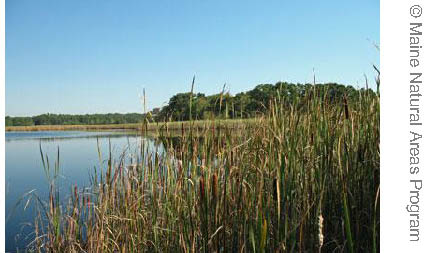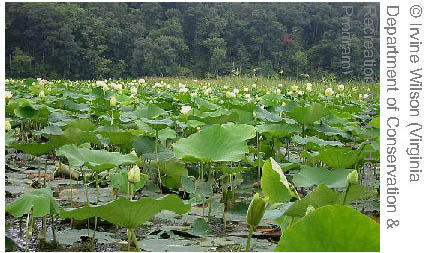The Emergent swamp macrogroup consists of the following habitats:
Laurentian-Acadian Freshwater Marsh


Regional distribution:
CT, DC, DE, MA, MD, ME, NH, NJ, NY, PA, RI, VA, VT, WV. 906,723 total acres of habitat, of which 21.6% is conserved.
Description:
A freshwater emergent or submergent marsh dominated by herbaceous vegetation and associated with isolated basins, edges of streamways, and seepage slopes. Typical plants include cattails, marsh fern, touch-me-not, pondweeds, water lilies, pickerelweed, and tall rushes, species that tolerate sustained inundations and do not persist through the winter. Scattered shrubs are often present and usually total less than 25% cover. Trees are generally absent and, if present, are scattered. Zonation within a marsh is associated with water depth and length of inundation. This is a very broadly defined system, with many variants distributed widely in the Northeast.
Download the
pdf for this habitat for information about species, crosswalks to state names, and condition of this habitat.
Piedmont-Coastal Plain Freshwater Marsh


Regional distribution:
MD, VA. 45,739 total acres of habitat, of which 6.4% is conserved.
Description:
An herbaceous wetland that occurs in small basins and alluvial environments in the Piedmont and coastal plain of Virginia. Vegetation is zoned according to water depth, length of inundation, and substrate; submergent plants in the deepest water like pondweeds and water lilies give way to emergents like cattails and bulrushes, then shallower water species like arrow-arum and American bur-reed, and finally to species of periodically flooded shorelines like marsh St. John's-wort and various sedges. Most examples are semi- natural, a result of clearing and impoundments by humans and beavers in settings that would normally be swamps. It can fill with sediments over time, allowing woody shrub vegetation to get established, and is often associated with shrub swamps and wet meadows.
Download the
pdf for this habitat for information about species, crosswalks to state names, and condition of this habitat.